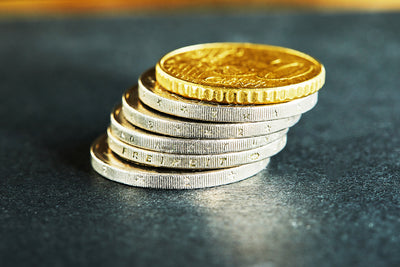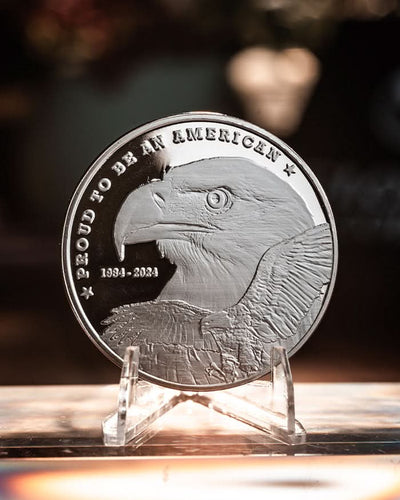Why Gold Is a Crucial Inflation Hedge in 2025
Disclaimer:
Global Coin is a dealer of precious metal coins and does not provide investment, financial, or legal advice. Any information provided in this content, including market commentary and insights, is for informational purposes only and should not be construed as investment advice. Investors should conduct their own due diligence and consult with a qualified financial professional before making any investment decisions. Gold and rare coin investments involve risks, and past performance is not indicative of future results.
Key Points
-
Research suggests gold remains a strong hedge against economic uncertainty and inflation in 2025, given slow global growth and geopolitical tensions.
-
It seems likely that central banks are increasing gold reserves, with record purchases noted in recent years, continuing into 2025.
-
The evidence leans toward rare gold coins offering potential for higher returns due to numismatic value, unlike gold ETFs which track spot prices.
-
There’s debate on whether rare gold coins or ETFs are better, with coins appealing to collectors for their historical significance and limited supply.
Why Gold Is a Crucial Inflation Hedge in 2025

In 2025, with global economic growth projected at 3.3% and persistent inflationary pressures, gold stands out as a vital hedge for investors. Its historical role as a safe-haven asset within the commodity market makes it particularly relevant amid slow growth, rising inflation, and geopolitical instability. This blog post, crafted by Global Coin, a dealer of precious metal coins, outlines why rethinking gold, especially rare gold coins, is essential for your portfolio.
Economic Context and Gold Prices’ Role

The global economy in 2025 is marked by uncertainty, with inflation rates at 3% for the 12 months ending January 2025, up from 2.9% previously, and forecasts suggesting persistence between 2.4% and 2.9% (U.S. Inflation Rates Over Time and the Forecast for 2025). The Consumer Price Index (CPI) plays a crucial role in analyzing these inflation trends, revealing the complexities of gold's effectiveness as an inflation hedge. Geopolitical tensions, including state-based armed conflicts and trade disputes, are top concerns, driving demand for stable assets like gold (Global Risks 2025). Gold’s low correlation with stock markets and finite supply make it a cornerstone for future-proof portfolios, especially as global debt and rising interest rates push investors toward non-yielding assets. Given the potential for higher inflation due to recent global events like the COVID-19 pandemic and the war in Ukraine, gold remains a critical hedge against inflation.
Understanding Gold as an Inflation Hedge
Gold has long been considered a reliable inflation hedge, and for good reason. As inflation rises, the purchasing power of a currency decreases, causing the value of goods and services to increase. Gold, on the other hand, tends to maintain its value over time, making it an attractive asset to hold during periods of high inflation. Historically, gold prices have shown a positive correlation with inflation rates, making it a popular choice for investors looking to hedge against inflation. When inflation rises, the value of gold often increases, preserving purchasing power and providing a buffer against the eroding effects of high inflation.
The Benefits of Gold as an Inflation Hedge

So, what makes gold such an effective inflation hedge? For one, gold is a physical asset that is not subject to the same market fluctuations as other assets, such as stocks or bonds. Its intrinsic value is derived from its rarity and the high demand for this precious metal, which helps to maintain its value over time. Additionally, gold’s lack of correlation with other asset classes makes it a great diversifier for investment portfolios. Unlike paper assets, gold can be held in physical form, providing a sense of security and stability during times of economic uncertainty. This combination of factors makes gold a good inflation hedge, offering protection against rising prices and preserving wealth.
Central Banks and Gold Demand
Central banks have been net buyers for 15 years, with purchases exceeding 1,000 tons annually in 2022 and 2023, and continuing into 2024 with 694 tons in the first three quarters (Central Banks | World Gold Council). In November 2024, net buying was 53 tons, with the National Bank of Poland adding 21 tons and the People’s Bank of China resuming purchases (Central bank gold statistics: November 2024). This trend is expected to persist in 2025, driven by emerging markets diversifying away from the USD amid de-dollarization, boosting long-term gold prices.
Rare Gold Coins vs. Gold ETFs: A Detailed Comparison
While gold ETFs offer convenience and liquidity, rare gold coins have unique advantages. Their numismatic value can appreciate independently of gold spot prices, unlike ETFs that track market prices (Rare Gold Coins as an Investment). Limited supply and historical significance attract collectors, potentially offering higher returns, as opposed to ETFs which are mass-produced and lack exclusivity. For instance, pre-1933 gold coins or French 20 Francs Rooster coins are highlighted for their potential appreciation beyond bullion value. However, there’s debate, with some arguing ETFs are safer due to liquidity (Are gold ETFs as safe as gold coins and bars?), while others see coins as better for long-term appreciation due to collector interest.
Buying Gold as a Hedge Against Inflation

If you’re considering buying gold as a hedge against inflation, there are several options to consider. One popular option is to invest in physical gold, such as gold coins or bars. This can be done through a reputable dealer or online retailer, ensuring you receive genuine products. Another option is to invest in gold exchange-traded funds (ETFs), which track the price of gold and can be traded on major stock exchanges. ETFs offer the convenience of liquidity and lower costs compared to physical gold. Finally, you can also consider investing in gold mining stocks or mutual funds that focus on gold and other precious metals. Each of these options provides a way to hedge against inflation, allowing you to choose the method that best fits your investment strategy.
Alternative Inflation Hedges
While gold is a popular inflation hedge, it’s not the only option. Other assets that can provide a hedge against inflation include Treasury Inflation-Protected Securities (TIPS), which are government bonds that adjust their principal and interest payments to keep pace with inflation. Real estate is another option, as property values tend to increase with inflation, providing a tangible asset that can appreciate over time. Commodities, such as oil and food, can also provide a hedge against inflation, although they can be more volatile than other assets. Finally, some investors may consider alternative currencies, such as the Swiss franc or the Japanese yen, which have historically been stable during times of economic uncertainty. Each of these alternatives offers different benefits and risks, allowing investors to diversify their inflation hedging strategies.
The Importance of Diversification

While gold and other inflation hedges can be effective in protecting against inflation, it’s essential to remember the importance of diversification. A diversified investment portfolio should include a mix of different asset classes, such as stocks, bonds, and commodities, to provide a hedge against various economic scenarios. Additionally, it’s crucial to regularly review and rebalance your portfolio to ensure that it remains aligned with your investment goals and risk tolerance. By diversifying your portfolio and including a mix of inflation hedges, you can help protect your wealth and achieve long-term financial success. Diversification not only mitigates risks but also enhances the potential for returns, ensuring a more resilient investment strategy in the face of economic uncertainties.
Investment Tips and Case Studies
Investors should consider physical gold for security, choosing reputable dealers like Global Coin to avoid counterfeit risks. Fluctuations in interest rates can significantly impact gold investment decisions, as they influence purchasing power and investment attractiveness. Case studies, like gold’s performance during 2008 and 2020, show it helped avoid losses, with high-net-worth individuals leveraging rare coins for amplified wealth protection. These examples align with historical data on gold price, reinforcing gold’s role in uncertain times.
Conclusion
In 2025, gold’s unique positioning—combining liquidity, stability, and long-term value—makes it essential, especially with rare coins offering exclusivity and potential for appreciation. Global Coin’s advantage lies in exclusive access to premium assets and expert guidance, encouraging investors to explore their collection for smarter gold investing.
Detailed Analysis of Gold Investment in 2025
Economic Context in 2025
The global economic outlook for 2025, as outlined in reports like the World Economic Situation and Prospects 2025, projects growth at 2.8%, unchanged from 2024 but below the pre-pandemic average of 3.2%. This stagnation, particularly in regions like Germany with a 0.2% contraction, is driven by weak investment and high debt levels. The US economic outlook shows uncertainty, with growth forecasts ranging from 1.5% to 2.7%, influenced by potential tariffs and immigration policies (US economic outlook 2025). This environment of slow growth and uncertainty underscores the need for hedges like gold.
Inflation remains a concern, with rates at 3% for the 12 months ending January 2025, up from 2.9% previously, and forecasts suggesting persistence between 2.4% and 2.9% (U.S. Inflation Rates Over Time and the Forecast for 2025). Factors like tariffs and geopolitical tensions could push rates higher, aligning with the blog post’s emphasis on gold as a hedge against inflationary pressures.
Geopolitical instability is evident, with reports highlighting risks like state-based armed conflicts and geoeconomic confrontations as top concerns for 2025 (Global Risks 2025). The Top 10 geopolitical risks in 2025 notes increased tensions, including potential trade wars under a new US administration, fueling demand for safe-haven assets like gold.
Gold as an Inflation Hedge: Historical and Current Role
Gold’s historic role as a safe-haven asset is well-documented, with research suggesting it protects against inflation and economic downturns, influencing the gold price significantly (The effects of economic uncertainty, geopolitical risk and pandemic upheaval on gold prices). In 2025, its low correlation with stock markets and finite supply make it a cornerstone for future-proof portfolios, especially as global debt and rising interest rates push investors toward non-yielding assets. The blog post’s case studies, like gold’s performance during the 2008 financial crisis and 2020 pandemic, align with historical data showing gold outperforming stocks and bonds during crises.
Central Bank Strategies
Central bank gold purchases have been robust, with net buying exceeding 1,000 tons annually in 2022 and 2023, and continuing into 2024 with 694 tons in the first three quarters (Central Banks | World Gold Council). In 2025, the trend persists, with November 2024 seeing a net addition of 53 tons, driven by emerging markets diversifying away from the USD amid de-dollarization trends (Central bank gold statistics: November 2024). This institutional demand is expected to drive long-term gold prices, supporting the blog post’s claim of increased relevance for private investors.
Rare Gold Coins vs. Gold ETFs: A Detailed Comparison
The blog post emphasizes rare gold coins over gold ETFs, citing several advantages. Rare coins hold numismatic value, which can appreciate independently of gold spot prices, unlike ETFs that track the market price. Their limited supply and historical significance attract collector demand, potentially offering higher returns, as opposed to ETFs which are mass-produced and lack this exclusivity. For instance, pre-1933 gold coins or French 20 Francs Rooster coins are highlighted for their potential appreciation beyond bullion value.
Gold ETFs, while offering liquidity and lower costs (e.g., SPDR Gold Shares with a low expense ratio), are less tangible and subject to market fluctuations without the added value of rarity. The blog post’s mention of Global Coin’s GCS Index suggests a proprietary grading system to ensure high-value assets, contrasting with ETFs’ standardized approach. However, there’s debate, with some arguing ETFs are safer due to liquidity, while others see coins as better for long-term appreciation due to collector interest.








Leave a comment
This site is protected by hCaptcha and the hCaptcha Privacy Policy and Terms of Service apply.